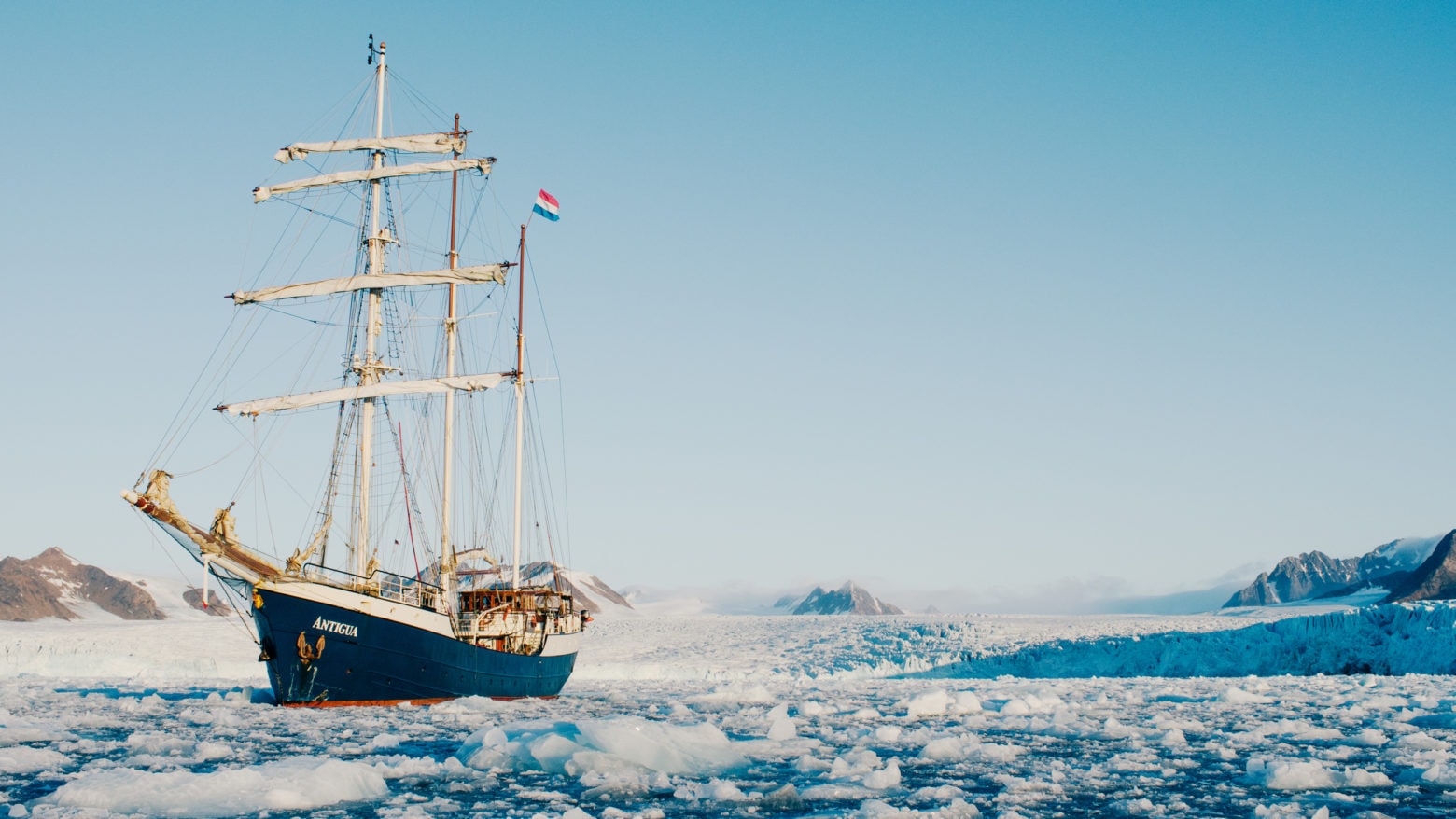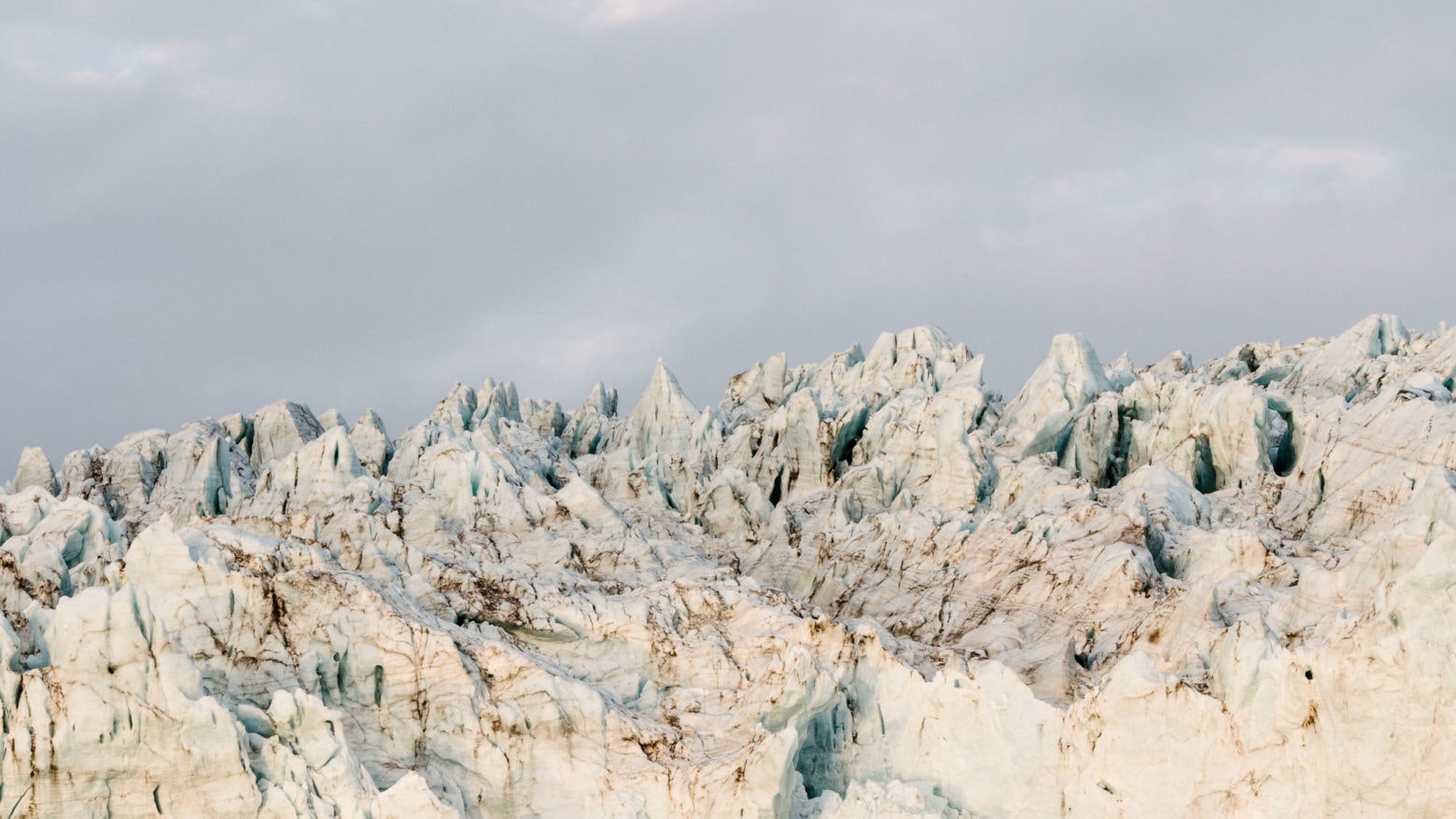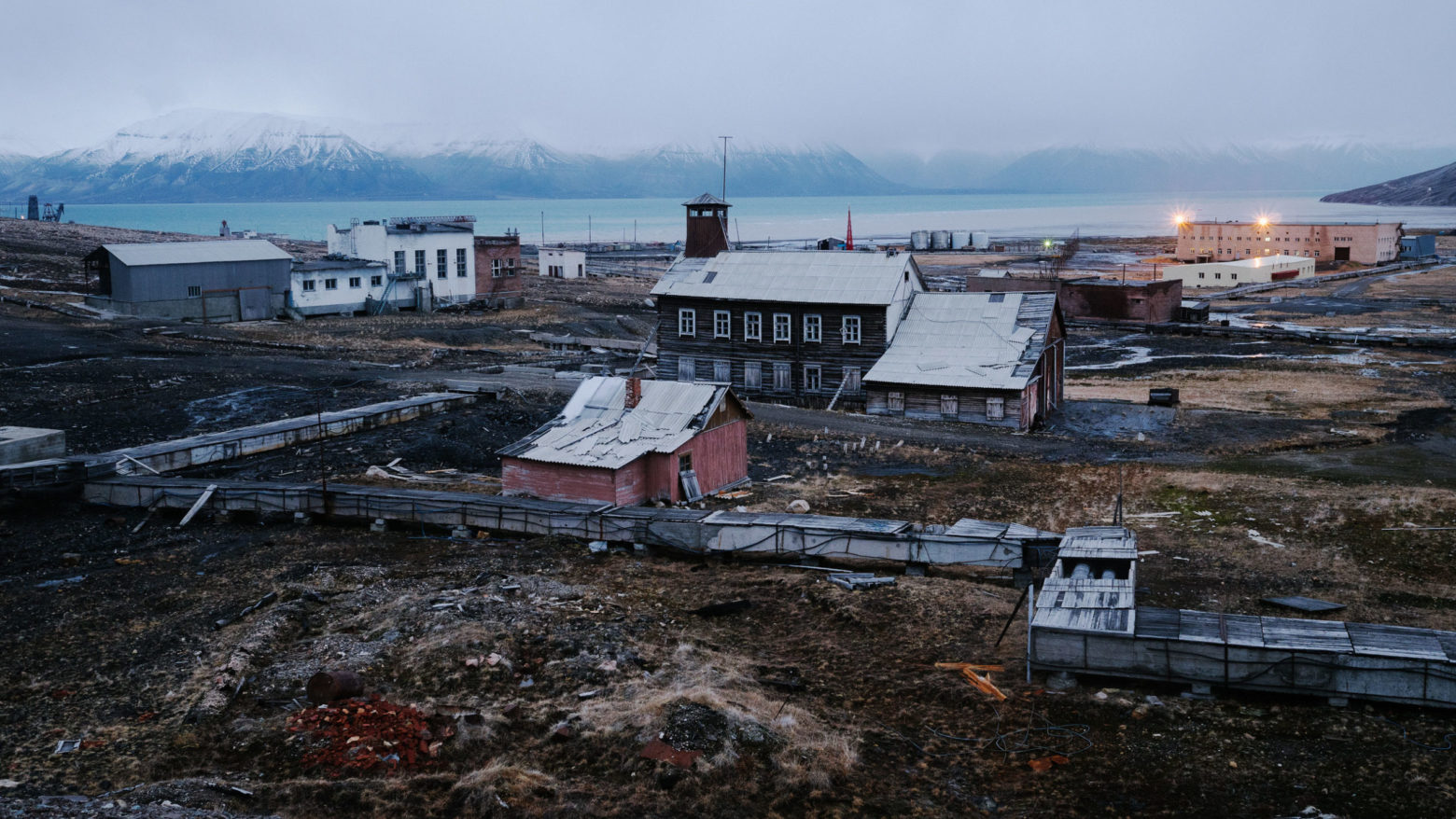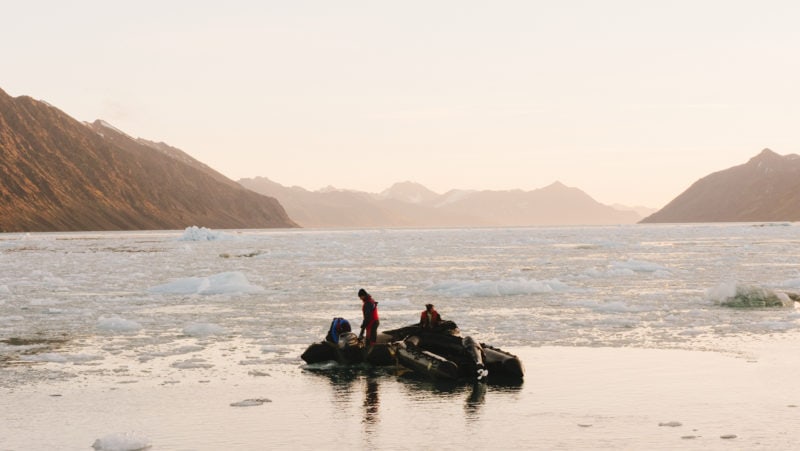Standing near a glacier on the shore of Spitsbergen, an island in the Arctic archipelago of Svalbard, I ask my guide, Kristin Jæger Wexsahl, what changes she has witnessed in the place she calls home.
“In seven years,” she replies, “I can’t say I’ve seen climate change. I’ve seen a lot of different weather. But when you sit down and you read a trapper’s diaries from the 1920s, his experience of the land, where he traveled, how he traveled, which routes he took—it is completely different than what I’m experiencing.”
But, she adds, you don’t even have to go back that far: Twenty or thirty years is enough. “If you look at ice maps and trip descriptions and route descriptions,” she says, you see trips you can’t take anymore. “It’s always just been open sea when I’ve seen it.”
In front of us, at some distance, is a glacier. From where I stand it seems concrete and permanent, yet Kristen tells me it has been steadily shrinking since she moved to Svalbard. Later that morning we will approach the glacier and I’ll see with my own eyes the melt she is describing, my hands able to reach out and touch what is disappearing. Our conversation turns to changes taking place in the Arctic: the loss of marine life, the warming waters, the thawing permafrost. I ask her how she feels about all these changes in the place she calls home.
“It’s quite a lot of sadness,” she replies, “in realizing that everything you love about the world is falling to pieces.”
Thick, gray clouds dispense mist and gentle rain across Billefjorden, a stubby fjord clawing its way inland from a large bay on Spitsbergen. The glacier rises out of aqua green waters with the force of millennia. Its body is deep time made visible. Its ice blue walls cover rock that is a billion years old. It is impressive, beautiful, and doomed.
On the opposite shore lies the abandoned Soviet mining town of Pyramiden, built decades ago to house men who came to wrench coal from the seams of the mountains that ring the landscape. A town built to take what was frozen, encased in time and rock, and release the heat hidden inside.
On the second floor of a stoutly built but decaying building at the edge of town, a mural fills a whole wall. Swaths of blue and white and black depict the waters of the fjord and the mass of Nordenskiöldbreen. Walk out to the building’s front deck and you can see the glacier for yourself. It appears as if it could plunge straight across the fjord, burying the town beneath it. Someday, in one sense, it will. The Nordenskiöldbreen glacier is rapidly melting.
A territory administered by Norway, Svalbard lies roughly 1234 miles north from Oslo. Its largest town, Longyearbyen, is the northernmost spot on the globe serviced by commercial flights. The opportunity to visit arrived in 2017 when my application to join the Arctic Circle Residency as a filmmaker was accepted. An arts residency program that places artists and educators aboard an Arctic class, three-masted ship named the Antigua for fourteen days, we sailed along the coast of the largest island in the chain, Spitsbergen, making landfall along the fjords, islands, and coastline, allowing us the opportunity to create work in response to the dramatic landscapes of the polar north. Led by a team of polar guides, we were versed in the geologic and narrative history of each location we visited, before being given the freedom to explore on our own as our guides kept a watchful eye for polar bears.

The archipelago is a mixture of geologic elements that were once part of every continental landmass that has ever existed, drifting northwards across millennia, grinding together and over one another—a slow process of mineral coupling that formed the mountains and rock that compose Svalbard. Devoid of human life until the seventeenth century, when adventurous and desperate fortune-seekers arrived, they came first for the whales in its fjords, then for the fur-bearing mammals on its land, and, finally, for the coal buried in its seams. Demand for the ore and the heat it produced allowed permanent settlement for the first time in the late nineteenth century. Now tourists arrive on its shores, seeking remote, wild wilderness, at the cost of massive C02 emissions released by the planes and cruise ships that deposit them in Longyearbyen. Svalbard is now the most rapidly heating region on the planet. Its average temperature has risen four degrees Celsius since 1971, and the change in winter averages is even more dramatic—rising 7C, with another 3C predicted by 2100. These islands, a birthplace of the European oil industry, are a landscape transformed by fossil fuels.
In Svalbard, past and future meet. Geologic time and the stories it contains about our planet, and its future, are revealed through science and technology. On an open plain above the port of Longyearbyen sits the Kjell Henriksen Observatory. Cameras beneath the glass domes atop its roof gather images of the sky above. They track the movement of the stars, the lights of the Auroras, and our shifting weather patterns. Further north, international research teams at Ny-Ålesund study the Arctic environment. Through observations of how Svalbard’s historic body is changing, they make predictions about the future. In both locations, radar dishes and camera arrays stand out like alien technologies against snow-covered landscapes. Above it all, circulating at double their normal rate, satellites appear like so many stars. The images they produce allow scientists to track the loss of ice in the region. While we think of these tools as looking out at the world, they also reflect back upon us. Their reflection reveals the tragic ingenuity of a species that can monitor the destruction of its own habitat in minute detail.
Yet the Arctic landscape is a notorious trickster. In a world in which two of the primary features are one element—water and ice—raw perception is untrustworthy. Technically a desert, the Arctic, like all deserts, produces mirages. Yet Svalbard, full of hulking mountains and imposing stone, seems to carry a weight that makes it feel solid and tangible, never changing, trapped in human prehistory. But like the ice floes that surround it, their eerie, Siren-like crackling filling one’s ears as ice moves over and around itself, it is a landscape in motion. Its blue glaciers and green waters mirror a viewer’s internal fears or desires: A sanctuary of the sublime, or, of nature’s terrifying indifference to humanity.
“These mountains and the landscape I see around me is a landscape of beauty,” said my colleague, the photographer Iveta Gabalina, one evening. “But they are cold and senseless, they don’t care about us. They can exist without us.”
But we cannot, and, perhaps, will not, exist without Svalbard. From the Arctic jet streams that regulate our weather patterns to the ice that reflects back the heat of the sun, keeping our global temperatures within a habitable range—as this region goes, so goes the environmental conditions that have supported humans for millennia. Svalbard then, like the greater Arctic, embodies the consequences of the global North’s inability to confront the massive ecological forces it has unleashed. Its melting glaciers and thawing permafrost become our solemn hourglasses, counting down the time we have left until all sense of normalcy has passed, their melting surfaces betraying the heat we have let out into the world.
With the time before our departure shrinking, we sailed towards Longyearbyen across Isfjorden, one of Spitsbergen’s largest fjords, then made a detour north to enter the smaller bay of Billefjorden, for our final two landings. It was there we encountered Nordenskiöldbreen.
Roughly sixteen miles long, the glacier is a massive presence in the fjord. Approaching the shoreline, a large portion of the glacier looked healthy. Despite the dull, somber light of the day, its numerous ridges, shaped like the suddenly frozen surface of a turbulent sea, were mesmeric: the bay’s green-blue water played against the brilliant blue white of the ice.

But the illusion melted as we came nearer. That there was a large stretch of beach for us to land on was a clear omen. Standing on the shoreline exposed by the glacier’s retreat, we were surrounded by naked, whale-skin-gray rock. Thickly pebbled beach gave way to muddy, stone-dotted ground.
To see the glacier up close was in some sense to see it dying: Glacial meltwater flowed over still-frozen, drab, dirt-smeared ice along the edge of its body, the water dripping onto soft, muddy ground. This running water at the base of a glacier is the sound of seas rising. It is a pleasing, murmuring trickling, like a garden fountain.
We stood on the beach near two enormous layers of dark bedrock revealed by the retreating ice. The ground sloped upwards in between two of the rock formations, like a valley passing through mountains. Above this gap was a thick layer of glacial ice, which formed a curved, cavernous ceiling. Despite the pale light of the day, brilliant, aquamarine-colored ice shimmered along the cavernous roof. We were allowed to walk up the slope of the moraine to the cavern mouth, but could not enter. The air coming from inside was cold and wet. Like gentle rain, droplets of water fell from the ice ceiling, the water splashing against the ground producing a hypnotic rhythm.
The threat of sea rise that will one day flood our coastal cities and river deltas begins here, in places like this. The single drops of water falling from the glacial cave formed trickling streams, which were drawn by gravity from the mouth of the cavern toward the bay below. Gaining speed and mass as they moved downhill, multiple streams converged at the base, becoming thick streams of rushing water that carved out shallow creek beds through the mud and stone of the beach. Standing on the slope overlooking the shoreline, all this water looked like blue veins coursing over the dark surface of the beach, a miniature river delta meeting the vast ocean.
From Greenland to Antarctica, such scenes are common, though in isolation their power is hard to see. How could these streams of melting ice cause the oceans to rise? I could only see ice, water, and sky. The alchemy by which their states shifted and, in turn, affected environments around the world, was invisible to me.

As we took in this scene from the hillside, the cavern to our backs, our guide Marte Agneberg Dahl, spreading her arms out toward the bay, told us that the beach in front of us had been covered by glacial ice just a few years ago. Pointing to the area of open water that had then been shoreline, she told us the Antigua used to dock there. The ship was now anchored over a football field’s length away. Her calm, matter-of-fact voice belied the frightening loss before us.
Standing near this melting glacier, I tried to visualize myself in thirty years, standing at the edge of what was once Ninth Avenue in Manhattan on a cold winter day, water from the Hudson River running up to the edge of my feet. This older me is, in turn, thinking back to this moment at the glacier, as I watched its water flow out into the ocean, trying to imagine my future self in a flooded Manhattan, thinking back to the moment when he witnessed the source of what would irrevocably alter the world he had known.
As a misting rain settled over the shore of Nordenskiöldbreen, we returned to the Antigua. The crew pulled anchor, turned her bow west, and we set sail for Pyramiden, a town that seems a harbinger of the future.
The clouds sat full and gray in the late October sky. Cold water the color of the sky lapped at the sides of the ship and the creaking wooden port we docked alongside. From a rise of land above and beyond the dock stood a three-story coal plant, made of stout, rectangular concrete boxes stacked like children’s blocks. Its faded red exterior, chipped away by the elements, revealed abstract patches of white and blue spread in between the exterior coat so that the building appeared like an enormous Philip Guston canvas, stretched and unfinished, at the end of the world. The plant had sat silently for twenty years.

The ground beyond the dock was muddy and black, full of fine gravel and oil residue. It appeared as if the buildings had slowly dragged themselves across the landscape in an attempt to escape their own abandonment, leaving in their wake rutted trails of cracked tundra and clotted permafrost.
Like Detroit and other cities left to rot across the American Rust Belt, Pyramiden foreshadows a form of abandonment that might be common in eighty years, as extreme weather and flooding makes geographic regions barely habitable. Though the glacier offers a glimpse of geologic changes compressed into a human time scale, Pyramiden bears witness to social changes that required no expertise or ties to place. The town’s abandoned and collapsed buildings created the clear impression that something had gone wrong.
Founded in 1910 by Sweden and sold to the Soviet Union in 1927, the town’s expansion, and that of its coal mines, began with urgency after World War II. Within decades, however, the Communist experiment had begun to fail. Coal mining had become prohibitively expensive by the 1970s, but pride stood in the way of fact. Through a unique legal loophole of Svalbard’s territorial status, the town was not part of the USSR—this meant it could be openly visited by Westerners—therefore, it needed to represent the best the nation had to offer. In order to make the Soviet system appear a success to outsiders, generous benefits and amenities were lavished on its infrastructure and the resident coal workers and party apparatchiks, making it one of the premiere work assignments in the USSR. These state subsidies sustained an increasingly unprofitable industry into the ’80s. When the USSR collapsed in 1991, the town went with it. A small population of a few hundred held on, but the state-owned mining company that managed Pyramiden officially shut down the operation in 1998. In only seven years, a town that had once been held up as one of the finest examples of Soviet planning and state welfare, in the frozen Arctic no less, was rapidly abandoned to the surrounding landscape.
An elevated, wood walkway leads to the center of Pyramiden. Constructed to act as a bridge over the shifting surface of permafrost during summer thaws, it also houses beneath its floorboards pipes and electrical wiring running from the power station to the town. But what once was a navigable footpath now tilts at odd angles, full of holes and rotted planks of wood. Drawing near the town center, the buildings become tightly packed and connected via a series of traditional sidewalks. While the original structures of the town had been laid out according to the topography of the landscape, construction of new buildings in the 1960s was arranged symmetrically, in a grid along an axis around which a town center was formed. Past the original housing units and town hotel lies a center around which all the principal buildings face. Bounded to the west by the Cultural Palace, which looms large at the end of the town, and to the east by a large apartment building that was once home to upper-level staff and management, the square is flanked by smaller apartment blocks, a hospital, a bathhouse, and an administrative building which housed the northernmost outpost of the KGB. A mounted bust of Lenin overlooks the square. A cultural hero whose creation has long since run away from him, Lenin’s presence is more a sign of impotence than importance.
Today, the town hosts a handful of workers at the Hotel Tulip, the only building still drawing power in the town, who in addition to offering drinks and snacks for tourists ferried in from Longyearbyen, provide a subsistence level of maintenance for the hotel and the few buildings still in operation.

On the western edge of town sits the Cultural Palace, a squat, brick building that once housed a sports hall, library, studio spaces for dance, music and fine arts, along with a combined theater and cinema, the premiere theater of the Arctic in its day. Its walls are still covered in poster boards with announcements for performances, propaganda commemorating World War II victories, amateur watercolor and oil paintings, and framed black and white photographs of early settlers.
The edge of the cavernous theater was illuminated by winter light leaking in through the windows of nearby offices, but beyond the open doors, the light was swallowed up. Through the dark, a single piano note wobbled out. As my eyes adjusted, I could see a solitary grand piano on the stage. Seated in front of it, I made out two of the artists in our group, Devra Freelander and Ash Goh Hua. Nervous laughter followed the rusty note. Realizing there was no one but us to guide how we interacted with the space, Devra’s fingers touched the keys, coaxing a simple, ragged melody from the out-of-tune strings within.
Wandering the halls, the flashlights on our phones lit the way and cast deep, unsettling shadows on the surfaces around us. Their pale light illuminated file cabinets abandoned in a hallway, drawers sticking out as if whoever was in the process of moving them suddenly had to flee.
We explored rooms with faded, peeling wallpaper and abandoned offices with cluttered desks: newspapers from the end of the Soviet empire, closets filled with film reels in jumbled piles of unspooled celluloid. Here, the overturned bottle on a shelf with the label facing out; there, the damaged, black and white photographs of life around town neatly arranged on a table.
When people called Pyramiden home, the 24-hour summer sun would have lit the rooms on clear days. Well-dressed couples would have laughed and greeted friends before making their way into the theater for a concert. The visible shell of decay spoke to the vibrant life that had once existed. As late as 1990, 2,500 people called this community home.
Two decades later, the lawns are brown and gulls nest in the windows of empty apartment buildings, their excreta staining the walls and fouling the grounds around them with a strong stench.
In the hotel bar, against walls covered in deep shades of Soviet red and gold, a flatscreen TV played a video of snowsuit-clad young people dancing and whirling across the abandoned town in bright summer sunlight, to the tune of Pharrell’s “Happy.” They congaed around rust-covered machines on a factory floor and leapt around on the old basketball court. In the empty indoor swimming pool, they performed the Monkey, arms moving up and down with closed fists. They danced in old mining tunnels, in front of Lenin’s statue. The video took the theme of the ruin-as-tourist-playground and ran with it, blurring all boundaries between satire and earnestness.
Over a round of horseradish vodka, we laughed at the absurdity of the video, our faces glowing warmly from drink. Behind the bar, a blonde-haired, sharp-jawed teenager played pop-techno over an old CD stereo unit sitting on a corner shelf.
This spectacle felt like a view of the future as much as the abandoned town itself. Wealthy tourists and adventure-seekers, cocooned from the elements, travel in relative luxury, visiting ever-widening ruins of a society they contributed to ending. In fifty years, it’s easy to imagine the children of today’s oil executives navigating Venice-like waterways of a city like New Orleans: taking in the surreal scenes of a city mostly swallowed by the ocean, returning to luxury hotels on the remaining dry strip of the French Quarter for cocktails and a meal of lab-made steaks, before jetting back to their safe havens in New Zealand. Meanwhile, privileged artists on some similar residency program will sit at the once grand Carousel Bar in the Hotel Monteleone on Royal Street, sipping Sazeracs and rolling their eyes at a video cheerfully promoting glass bottom boat tours of the Ninth Ward.
The drinks were flowing liberally when the guides told us we needed to make our way back to the ship. Out in the cold night, we were told to pack in tightly, as the guides had to keep an eye out for polar bears that lurked through the town. The lights receded behind us as we headed towards the dock. As we approached an intersection, a small herd of reindeer emerged from the shadows behind a row of squat buildings in the distance, their bodies illuminated by a single halogen lamp, a lonely soldier on guard duty. They watched us with curiosity, and we them, before they slipped silently back into the darkness, beyond the light’s edge.
